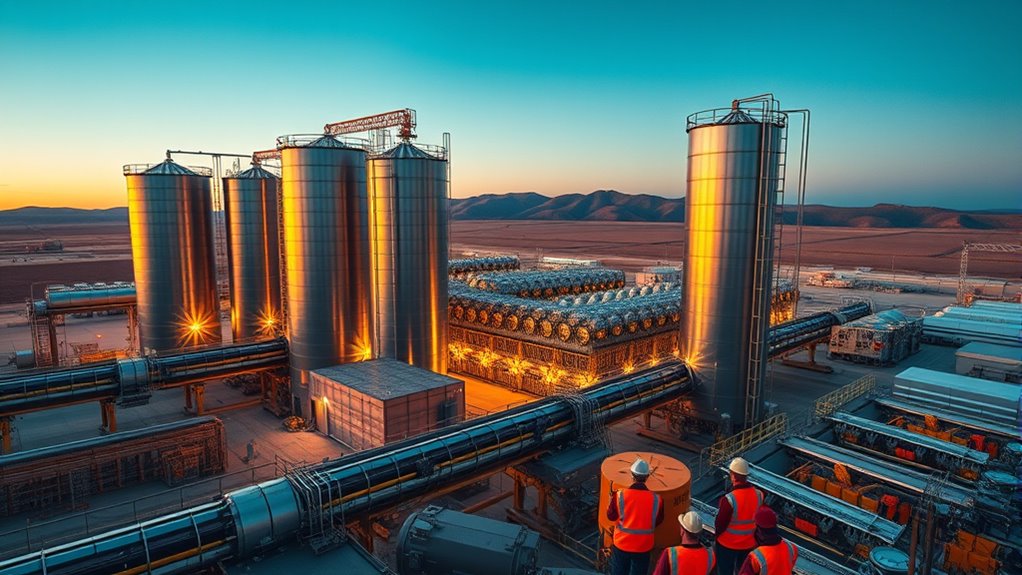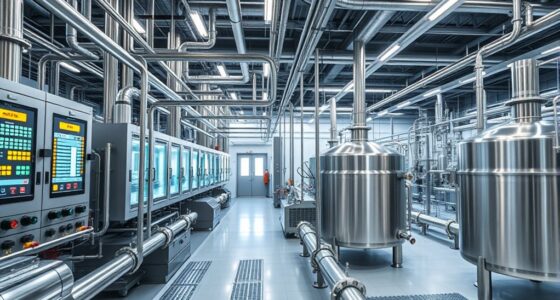Cathode chemistry influences where battery gigafactories are built because regions with abundant resources like nickel or iron attract investment to produce specific lithium-ion cell types. Companies choose locations based on resource availability, supply chain resilience, and regional policies. This focus helps optimize costs and quality while supporting sustainability goals. As you explore further, you’ll discover how these regional choices shape the future of battery manufacturing and innovation.
Key Takeaways
- Regions rich in resources like nickel or iron attract gigafactories specializing in specific cathode chemistries.
- Investment in R&D and manufacturing facilities aligns with local resource availability and regional market demands.
- Different cathode chemistries influence supply chain logistics, prompting localized sourcing and production hubs.
- Strategic resource access and chemistry innovation determine the location and success of battery gigafactories.
- Regional policies and incentives promote investment in particular cathode technologies, shaping gigafactory distribution.

Have you ever wondered how the world is ramping up its battery production to meet the growing demand for electric vehicles and renewable energy storage? It all starts with the intricate process of cell manufacturing, where raw materials are transformed into the batteries that power our modern world.
As demand skyrockets, companies are investing heavily in battery gigafactories—massive facilities designed to produce batteries at an unprecedented scale. But building these giants isn’t just about size; it’s about optimizing every step, from sourcing raw materials to the final assembly.
This is where supply chain logistics become essential. Ensuring a steady flow of high-quality components, like lithium, cobalt, and nickel, requires a finely tuned logistics network. Any disruption in supply chain logistics can cause delays or increase costs, hampering overall production efficiency. That’s why regional investments often focus on establishing robust, localized supply chains to reduce dependencies on distant suppliers and minimize risks.
In the domain of cell manufacturing, advances in cathode chemistry are at the forefront of innovation. The cathode, as you probably know, considerably influences a battery’s energy density, lifespan, and safety. Different chemistries, such as NMC (nickel manganese cobalt) or LFP (lithium iron phosphate), are selected based on the targeted application and regional resources. cathode chemistry also plays a critical role in shaping the environmental footprint of battery production, prompting ongoing research into more sustainable materials.
Regions rich in specific raw materials tend to favor certain chemistries, which in turn shapes investment patterns. For example, areas abundant in nickel might see a surge in NMC-based gigafactories, while regions with plentiful iron may lean toward LFP batteries. These choices impact the entire supply chain, from raw material extraction to cell manufacturing processes.
Regions focusing on cathode chemistry also drive regional investment in R&D facilities, aiming to develop more sustainable and cost-effective materials. As you look at new gigafactories, you’ll notice that they’re often situated to capitalize on local resources and skilled labor, reducing transportation costs and enhancing supply chain resilience. Strategic resource allocation plays a key role in determining the success and location of these facilities.
This localization helps manufacturers control quality, lower expenses, and respond quickly to market shifts. Furthermore, regional policies, incentives, and environmental considerations influence where these gigafactories are built, creating hubs of innovation centered around specific cathode chemistries.
Ultimately, the success of battery gigafactories hinges on a complex interplay of cell manufacturing expertise, supply chain logistics, and regional resource availability. By aligning these factors with cutting-edge cathode chemistry, regions can attract investments, foster innovation, and build the supply chains necessary to meet the world’s electrification goals.
It’s a race driven by chemistry, logistics, and strategic foresight—all working together to power the future.
Frequently Asked Questions
How Do Local Regulations Impact Gigafactory Development?
Local regulations substantially impact gigafactory development by shaping where and how you can build. Zoning restrictions determine suitable locations, often requiring you to navigate complex permit processes. These regulations can delay projects or increase costs if they’re strict or unclear. Staying informed about local rules helps you plan effectively, ensuring your facility meets all requirements and avoids legal issues, ultimately speeding up your development timeline.
What Are the Environmental Impacts of Cathode Material Extraction?
You should know that extracting cathode materials causes environmental degradation, harming ecosystems and local communities.
It also raises concerns about mineral sustainability, as high demand strains finite resources.
Mining processes can lead to water contamination, habitat destruction, and air pollution.
How Does Supply Chain Logistics Influence Gigafactory Location Choices?
Supply chain logistics is the backbone of your gigafactory’s success, like the veins that keep the heart beating. You’ll prioritize regions with strong supply chain resilience and top-tier logistics infrastructure to minimize delays and costs.
These factors influence your decision, ensuring smooth material flow and quick access to essential components. Choosing locations with reliable logistics helps you stay agile, competitive, and ready to meet the rising demand for batteries.
What Innovations Are Emerging in Cathode Chemistry for Batteries?
You’re exploring emerging innovations in cathode chemistry, focusing on advanced synthesis methods that improve battery performance. Researchers are developing new materials with enhanced stability, which extend battery lifespan and safety.
These innovations also aim to reduce reliance on scarce resources and lower costs. By advancing material stability and refining synthesis techniques, you can expect more efficient, durable batteries that support the growing demand for electric vehicles and renewable energy storage.
How Do Regional Policies Incentivize Gigafactory Investments?
They say, “A rising tide lifts all boats,” and regional policies do just that by encouraging gigafactory investments. You benefit from tax incentives that lower costs and workforce development programs that make sure you have skilled workers.
These policies attract companies to your area, creating jobs and boosting the local economy. When regions prioritize these incentives, they make it easier for gigafactories to thrive and innovate in battery production.
Conclusion
Ultimately, your understanding of cathode chemistry’s vital role can catalyze smarter, more strategic gigafactory investments. As regions ramp up resources and research, you’ll see how specific chemistry choices shape supply chains, spark sustainable growth, and sustain success. Stay savvy, stay strategic, and you’ll steer toward a brighter, battery-powered future. Remember, the right chemistry charges the region’s resilience, revolutionizing the renewable revolution right at your fingertips.









